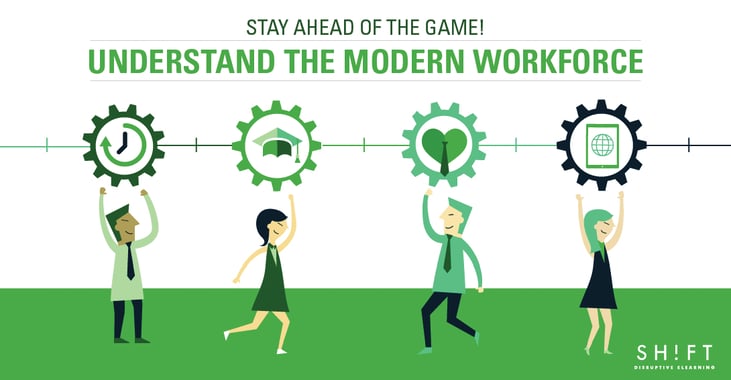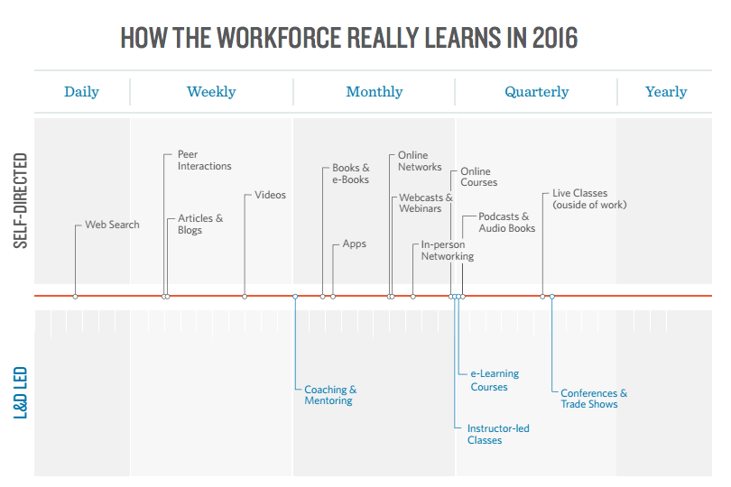How well do you know the people you lead?
How can you create value for your employees, so they stick around and support your business visions?
Are you sure that your employees are happy and don’t sigh because they believe the grass is greener on the other side?
To be an inspiring leader, you have to understand the modern workforce. You have to delve into their minds to find out what inspires them to come to work every day (or if they have to beat themselves to come to work) and what keeps them around (or are they eyeing greener pastures). You would want to know how they expect you to train, inspire, and help them succeed in their careers. You should also be aware of the trends in the workplace and the changing needs and aspirations of the workforce.

Here are four studies of 2016 that sum up what’s going on at the workplace and inside the minds of these modern workers.
1) 2016 Global Human Capital Trends by Deloitte
The 2016 Global Human Capital Trends report is for training professionals who want to be aware of the “sweeping global forces” that are redefining how workplace functions and how workers are expected to carry out their duties. The data was gleaned from 7,000 respondents in more than 140 countries.
According to the report, the following changes are currently reshaping workplaces around the world:
- Demographic Shifts: According to the findings, 50-60 percent of the workforce are millennials who learn differently and have different learning needs.
- Need for Increased Speed for Time to Market: The shifting dynamics of the marketplace demand that you continuously adapt your business models to decrease the time between conceptualizing a product and marketing it. Today, business models are rendered obsolete in the blink of an eye.
- Digital Dominance: The millennial generation was born into and has grown up in a digital world. Most do not know any other way to consume content.
It is not enough to commission courses, schedule training sessions, yank your employees from their desks to attend the classes, and have them leave with certificates and badges. In this way, you will only manage to create a bunch of workers whose heads are brimming with facts, theories, and statistics that they don’t know how they will put to use. To ensure that employees “learn” in a way that they can apply the knowledge to troubleshoot and synthesize past and current experiences to innovate, you have to create learning that clicks, stirs, sticks, and transforms.
The above findings throw up the following insights:
- More than 8 in 10 executives consider on-job learning to be important (40 percent) or very important (44 percent) for business development and continuity. The takeaway: Employers need to create and nurture a culture of learning within their organizations.
- Employees across all bands expect employers to provide them with continuous, dynamic, and self-paced learning opportunities. The takeaway: To create valuable employee-centric learning, L&D professionals have to think beyond static learning strategies, outdated platforms, and internally-focused (read: constricted) learning.
Here’s the link to download the full report. And here's a summary of the 10 top trends listed in the report:
2) The Deloitte Millennial Survey 2016
This survey was carried out amongst 7,700 millennials from 29 countries. The respondents were all born after 1982, have a college or university degree, and work full-time mainly in private companies with 100 or employees.
This report is a wake-up call for those employers who still believe their employees (or at least, most of them) will stick around forever. This is the most striking finding from this report: about two-thirds of the current batch of Millennial employees want to leave their present organizations by 2020!
And here are some more eye-opening findings from this report on what motivates Millennials to work:
- Millennials value professional and personal growth more than just having a job.
- Millennials feel valued when they realize their employers are investing in their development.
- Many millennials don’t stay for more than 2-3 years in an organization that doesn’t have a learning culture.
- Only 28 percent of millennials across the world and regardless of gender believe their skills and talents are being fully utilized in their current organizations.
- 71 percent of those workers who are contemplating leaving their current organizations within the next two years cite unhappiness at how they are being groomed to become leaders.
So here’s the (sobering) lesson: loyalty is not to be taken for granted; you have to earn it by proving yourself worthy of meeting employee expectations. This post lists some ways you can earn the trust and loyalty of your millennial workers.
Here’s the link to the Deloitte report. And here's the executive summary of the report:
3) 2016: How Millennials Want to Work and Live by Gallup
According to the findings by Gallup, millennials seek engagement with their jobs. They don’t want to just work a 9-5 job. Take a look at these numbers that paint a picture of the mind of the typical millennial worker:
- Only 29 percent of millennials who are employed report engaging with their work. What this means for your organization: Only 29 percent of your millennial workers are driven by a passion for doing their jobs.
- About 16 percent of employed millennials are actively disengaged. What this means for your organization: This group is about to damage your business interests.
- 55 percent of employed millennials are not engaged with their work. What this means for your organization: You have in your workforce people who are just clocking their hours and dispensing their duties dispassionately.
Read more: 5 Secrets to Increase Employee Engagement With Technology
Here’s a summary of the findings from this report.
The Gallup study suggests employers recalibrate their thoughts and realign their workplace policies to resonate with the hearts of the millennials. Here’s how:
- Prioritize purpose over paycheck. Create a sense of purpose. Help your employees discover the meaning in their work. Everybody wants to believe that they are doing meaningful work.
- Create opportunities for employees to contribute. When their jobs are their lives, it is natural that millennials would want to believe that they are doing something that can bring about positive change. Create a platform for them to contribute and find meaning in their work.
- Prioritize development over satisfaction. Contrary to popular notion, millennials find most satisfaction from their jobs when they see themselves becoming better versions of their earlier selves. You can’t woo them or keep them hooked with tangibles like snacks on the house and ping-pong tables at the workplace.
- Create a culture where individual strengths are valued and nurtured. Know your employees and learn about their strengths. Then provide opportunities to them to work on their strengths and strengthen these. This is the smart way to develop a person’s skills. Weaknesses should be minimized, but it is a tall order to try and turn weaknesses into strengths.
4) Degreed's "How the Workforce Learns in 2016"
As an employer, you would want to know how your employees learn best, what resources they use most frequently to learn, and how often they seek L&D-initiated (vis-à-vis self-directed) structured learning programs.
Degreed surveyed 512 people to find out about the learning preferences of employees. Their answers are charted in the diagram below:

As the figure reveals, traditional L&D-led training is not enough. Now here’s a disclaimer: it is NOT obsolete, but L&D-initiated learning cannot not fill all the learning gaps.
People are learning in different ways and in different places. For instance:
- Almost 85 percent of the respondents reported learning on their own by searching for information online at once a week.
- About 70 percent of the respondents learn from watching their peers at work or by interacting with them or by reading blogs and articles every week.
- 77% of workers report doing some learning on their mobile device.
- About 53 percent of those who took the survey reported learning from videos.
Clearly, employees today rely more on self-directed learning to fill knowledge gaps than wait around for L&D to realize their needs and roll out a course. However, L&D-led training is still important because 70 percent of the respondents reported taking these courses at least once a year and on an average, every 3-4 months.
Download the full report here.
The above studies clearly indicate what is needed to engage and retain the talented millennial employee in your organization. The purpose-driven and motivated millennial employee wants to be the best version of himself and is loyal to any organization that takes an interest in mentoring him and helping him realize his dreams.








